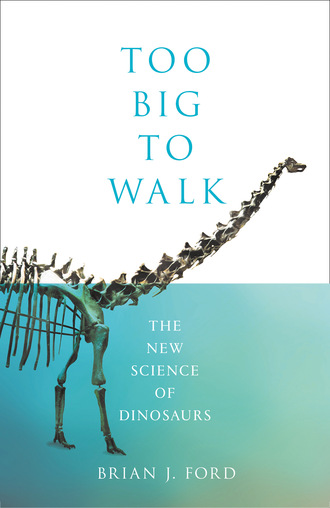
Полная версия
Too Big to Walk
Fossilized shells had been known for centuries and, as we have seen, they were conventionally interpreted as a natural consequence of the biblical flood. They were written about as radical new thinkers appeared on the European scene, and they caught the attention of Leonardo da Vinci around 1508, two centuries before the Enlightenment. Leonardo was not inclined to believe that they were the aftermath of the biblical accounts of the Noahic flood. Instead, he thought that their presence showed that the surface of the Earth had changed over time, and the fossilized remains represented an earlier, watery phase of the Earth’s ancient history. A generation later, a French Huguenot hydraulics engineer and ceramicist named Bernard Palissy wrote on the origins of fossils. He too believed that they were not the result of a flood, but had formed naturally in a manner reminiscent of that recorded by Avicenna. Palissy thought that mineral-rich water developed ‘congelative properties’ that transformed once-living creatures to stone. The first report of fossilized bones in Europe dates from 1605, when a British expatriate theologian named Richard Verstegan (living in Antwerp) became interested in fossils and, for the first time, recognized bones and teeth for what they were.17
Verstegan portrayed ichthyosaur vertebræ in a book, though he interpreted them as the remains of fish, which he took as evidence that Britain and mainland Europe were once connected.18
Fossils were collected by many enthusiasts during this period, though the first time they were scientifically described was by Robert Hooke in 1665. Hooke was a remarkable polymath and is best known for his role as the founding father of the science of the microscope. In his large folio volume Micrographia, published in 1665, Hooke devoted a section to fossils. His microscope showed him that fossilized wood had a structure identical to that of wood taken from a tree nearby, and he described the fossil in terms that fit perfectly with our modern understanding.
Hooke also featured a fine image of the microscopic spheres that comprise limestone. His drawing, captioned ‘Kettering-stone’, was described in his text: ‘This stone is brought from Kettering in Northampton-shire, and digg’d out of a Quarry, as I am inform’d.’19
His specimen was demonstrated to the Fellows of the Royal Society on Sunday, April 15, 1663, and attracted much attention. That was an auspicious date; his other demonstration that day was of thin sections of cork. Hooke observed that the specimen (from a wine bottle) showed itself to comprise numerous small boxes, the cell walls of the cork. The room-like nature of each component led Hooke to call them ‘cells’ – and this is the term that has come down to us today for all the cells that we see in living organisms.20
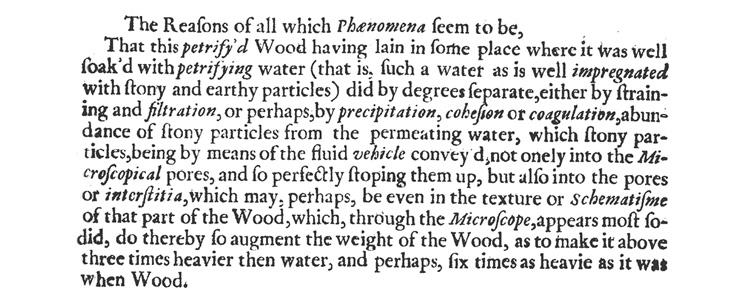
British philosopher Robert Hooke announced the first reasoned account of the process of fossilization in his book Micrographia, published in 1665. He thought that organic remains became filled with ‘stony particles’ and thus became petrified.
There were other fossils in the Royal Society collections at the time, and examples ranging from fossilized teeth to skeletons of fish were included in the Society’s catalogue of rarities, with descriptions showing that the petrification of organic remains was understood as a natural process.21
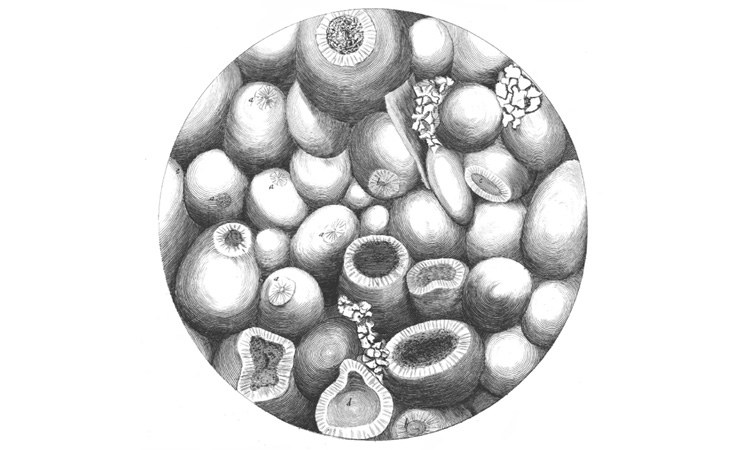
Under his microscope, Hooke could study the fractured surface of this Middle Jurassic oolite rock. He was the first to make detailed studies of rock formations and his conclusions about the processes of fossilization proved to be influential.
The collecting of fossils soon became a popular hobby for the learned classes. In 1695 John Woodward was appointed the first Professor of Geology at Cambridge University. He recognized the widespread occurrence of fossils and taught that they had been laid down by floods to form successive strata. Woodward became an avid collector of fossils and minerals, and eventually amassed over 9,000 specimens. He donated them all to the University, where they became the nucleus of what later became the Sedgwick Museum. In 1699 Edward Lhuyd published accurate engravings of ichthyosaur bones, vertebræ and limb elements in a book along with fossilized shark’s teeth and sea urchins, and a variety of petrified seashells and ferns.22
Lhuyd was appointed assistant to Robert Plot, a graduate of Magdalen Hall, Oxford, who had been appointed Professor of Chemistry and the first Keeper of the Ashmolean Museum in March 1683. It was Plot who published the first book to feature a picture of a dinosaur bone, The Natural History of Oxfordshire,23 in June 1677. He did not know what it was, and believed it to be a fossilized thigh-bone from a biblical giant, though it looked like a fossilized scrotum. Lhuyd went on to succeed Plot as Keeper.
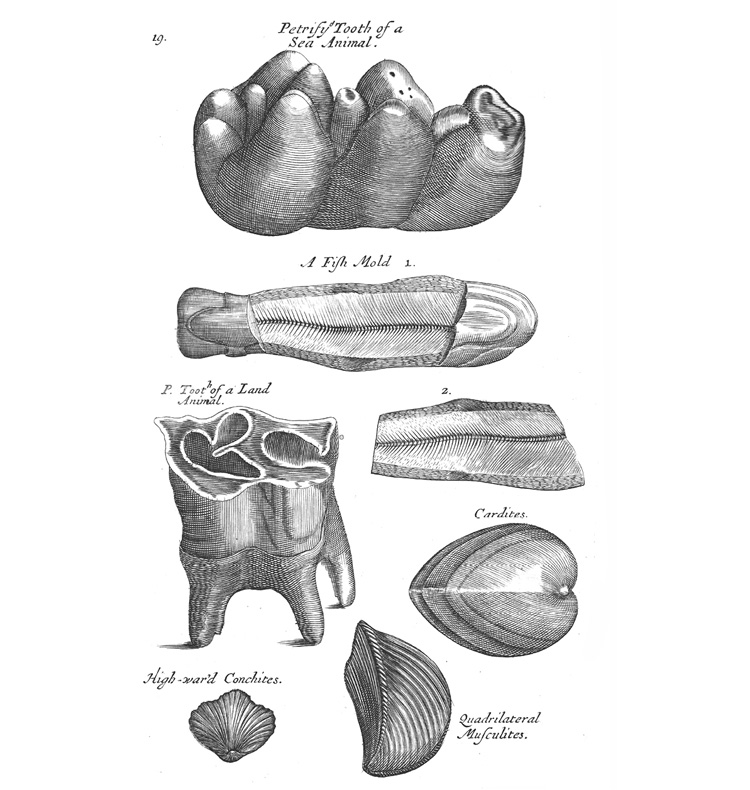
Nehemiah Grew published pictures including ‘Animal Bodies Petrify’d’ as table 19 in the book Musæum Regalis Societatis, or, A catalogue and description of the Natural and Artificial Rarities …, which the Royal Society published in 1681.
By the end of the seventeenth century, popular fossil finds were becoming more familiar in Britain and many had been well documented. In Switzerland, as in England, fossilized bones were always assumed to be human, and so when naturalist Johann Jakob Scheuchzer described two ichthyosaur vertebræ in 1708 he identified them as being the mortal remains of a person who had been drowned in the biblical flood and named them Homo diluvia tristis testi (‘sad evidence of man in the floods’).
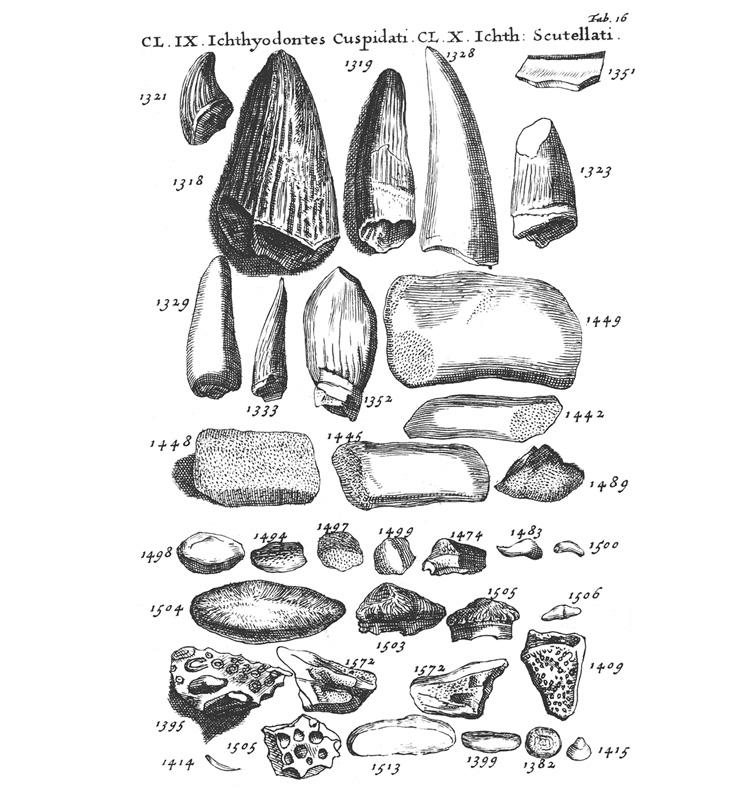
In 1697 Edward Lhuyd engraved his pioneering studies of fossils, and was encouraged by John Ray to publish them. Failing to find a publisher, he solicited subscribers and eventually had enough money to publish Lithophylacii Brittannici Ichnographia in 1699.
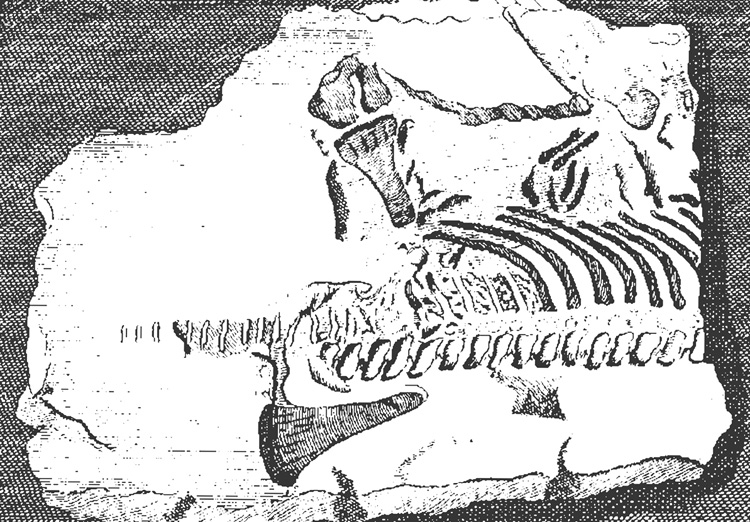
Robert Darwin, ancestor of Charles, discovered this skeleton of Plesiosaurus dolichodeirus in 1718. It was displayed in the local vicarage as the bones of a sinner who had died in the great flood, before Darwin recognized it as a fossil.
Then, in 1719, palæontology was quietly born. A clergyman scientist named William Stukeley, a studious man from a legal family, set out for the first time to develop the systematic study of archæological remains. Stukeley came from Holbeach, in Lincolnshire, and was a friend of Isaac Newton. Because of his scientific accomplishments, he was elected a Fellow of the Royal Society and in 1718 became the first Secretary of the Society of Antiquaries in London. The great English prehistoric monuments at Avebury and Stonehenge had long been sites of cultural interest, and indeed Stukeley himself was fascinated by the Druids, but neither site had been academically investigated until Stukeley showed interest in their origins. He examined them systematically, and this is how he came to be regarded as a father of archæology. In 1718 Stukeley visited the Reverend John South, Rector of Elston, near Newark on the boundary with Nottinghamshire, some 50 miles (80 km) from his home. In the nearby quarries of Fulbeck, Blue Lias rock was being mined and a fossil plesiosaur came to light. It was taken home by South, and became known locally as the Elston crocodile. The owner of Elston Hall was Robert Darwin, himself an FRS, and destined to become the great-grandfather of Charles Darwin. It was hoped that Stukeley could examine the ancient skeleton and find out more about it. Stukeley’s account of the discovery is meticulous:
There are Sixteen Vertebræ of the Back and Loyns very plain and distinct, with their Processes and intermediate Cartilages, Nine whole or partial Ribs of the Left-side, the Os Sacrum, Ilium in situ, and two Thigh-Bones displac’d a little, the Beginnings of the Tibia and Fibula of the Right-Leg; on one Corner there seem to be the Vestigia of a Foot with four of the five Toes, and a little way off an entire Toe, now left perfect in the Stone – there are no less than Eleven Joints of the Tail, and the Cartilages between them of a White Colour distinguishable from the rest. Sir Hans Sloan has a Fish-Sceleton, amongst his immense Treasure of Curiosities, found near this Place, given by the Duke of Rutland.
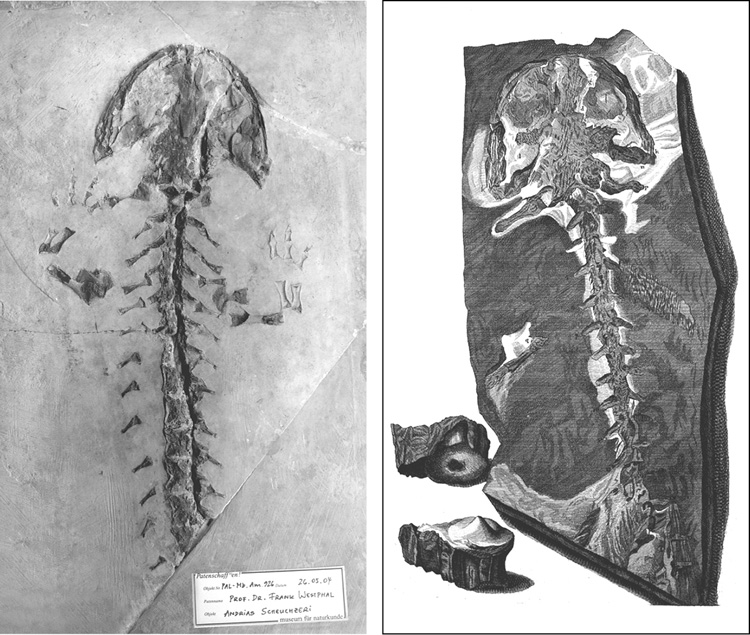
Left: When Johann Jakob Scheuchzer of Zürich was shown this fossilized salamander, he believed it to be the remains of a preserved human victim of the Noahic flood. It is in the collections of the Museum für Naturkunde in Berlin.
Right: Scheuchzer’s published account, Homo diluvii testis (A Flood Man), appeared in 1726. Conventional interpretations of these fossils (like Robert Darwin’s ‘Elston crocodile’) were taken as tangible evidence of biblical realities.
Stukeley discussed all this with his Royal Society friends, and his curious specimen was taken to London for inspection by the Fellows. An account of the discovery was presented to a meeting of the Fellows by Robert Darwin on December 11, 1718, and Stukeley was subsequently invited to publish a formal account in the Society’s journal. This was the first scientific description of a prehistoric reptile skeleton, which in 1824 was named Plesiosaurus dolichodeirus, and today the remains are on display at the Natural History Museum in London. Stukeley’s paper was a landmark; the era of palæontology was beginning to dawn.24
The swiss naturalist, Johann Scheuchzer, wrote extensively of his travels and also commented on fossils. He was shown a remarkable relic, a clearly preserved skeleton excavated from a quarry in Baden, and published it in 1726. Scheuchzer’s interpretation, just as we would expect at the time, was that this represented a human victim of the flood, trapped forever in its stony embrace and preserved for modern man to contemplate his fleeting fate on Earth.25
Twenty years later, the first vertebrate fossils to be excavated in the U.S. were discovered by Charles III Le Moyne, the second Baron de Longueuil, when he was exploring the course of the Ohio River in 1739. Le Moyne, who later became Governor of Montreal, had an active military career fighting against both the British and the Iroquois, and did much exploring for the burgeoning fur trade. This part of the Ohio River is swampy, rich with lush vegetation and dotted with mineral pools and hot springs that bubble from the strata seams beneath. Near the river bank Le Moyne discovered some huge bones. Nobody knew what they were, though eventually they were identified as belonging to a mammoth. For decades, the fossils that Le Moyne excavated were known simply as the ‘Ohio Animal’. The site in Kentucky is now open to the public as Big Bone Lick State Park, and the welcome signs today proclaim it as the ‘Birthplace of American Vertebrate Paleontology’. The bones excavated from this region are far more recent than dinosaurs; those magnificent monsters existed between 250 and 66 million years ago, whereas the mammalian fossils Le Moyne had found are less than 80,000 years old, and some date back only 12,000 years.26
These became the first American fossils to be formally described when Jean-Étienne Guettard published a summary of recent discoveries in palæontology. Guettard would become one of the pioneers of this emergent discipline.27
In 1780 Guettard went on to publish the first mineralogical map of France, which delineated where valuable resources might be found, and which was the first publication to demonstrate the volcanic origins of the Auvergne district of central France. The book also included maps of sites of interest to fossil collectors and was recognized as a pioneering publication in the emerging science of geology.28
Meanwhile, in England in 1755, a naturalist in Oxford named Joshua Platt made a momentous discovery: three ‘enormous’ vertebræ and then a femur that, when freed from the surrounding rock, weighed 220 pounds (100 kg). Platt had a lifelong interest in fossils, and at the time was studying the nature of belemnites. Colossal bones were not something he had previously experienced, so he sent them on to a Quaker botanist, Peter Collison, who was known for his broad interests in natural history and traded with America. Nothing more was done to investigate them – and the specimens have since disappeared. Fossils were attracting a wider audience and, when his paper on belemnites was published in 1764, Platt began with these words:
The public hath of late been agreeably entertained with description of many curious Fossils, discovered in different parts of this kingdom; but very little hath been offered with a view to ascertain their origin and formation; a point of much greater importance to a curious mind, than the most accurate descriptions, or the neatest delineations.
This was a key point: describing fossils was all very well, and drawing them, though intrinsically useful, did not reveal what they actually were. For his paper, Platt broke open the belemnites and neatly described what he found within. This was a pioneering attempt to explore the anatomy of fossils, a discipline that became a mainstay of palæontology in the centuries that followed.29
Another important discovery was made in England in 1766 when an ichthyosaur jaw bearing teeth was discovered in strata at Weston, near Bath. It was exhibited as the bones of a crocodile by the Society for Promoting Natural History in 1783; meanwhile, more ichthyosaur fossils were included in the plates for a book by John Walcott published in 1779.30
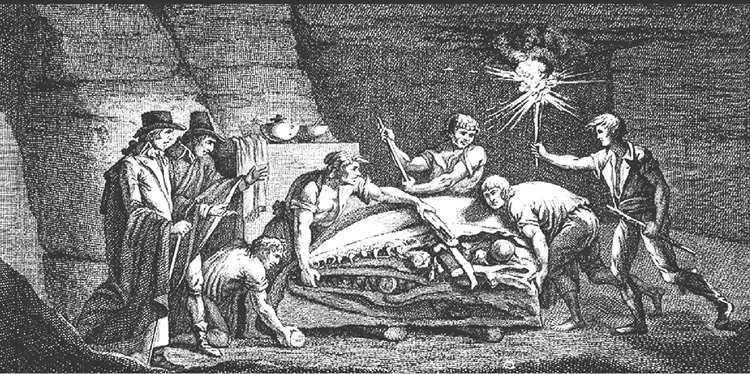
The huge skull of a mosasaur was excavated in St. Pietersberg, near Maastricht in the Netherlands, and was later given the name of Mosasaurus hoffmanni. This fanciful portrayal of the event was engraved in 1799 by G.R. Levillaire.
It was in 1764 that European scholars first encountered a dinosaur skull, though nobody realized its significance. This specimen had been dug out of a chalk mine by quarrymen at St Pietersberg, near Maastricht in the Netherlands, and took the form of fragments of jaws with rows of fearsome teeth which were assumed to be the remains of a crocodile. Two years later it was purchased from the miners as a curiosity by Lieutenant Jean Baptiste Drouin; Martinus van Marum, who had opened the Teylers Museum in Haarlem in 1784, subsequently acquired it as a highlight of the museum’s displays, and in 1790 he published a description of it as ‘a large fish skull’.31
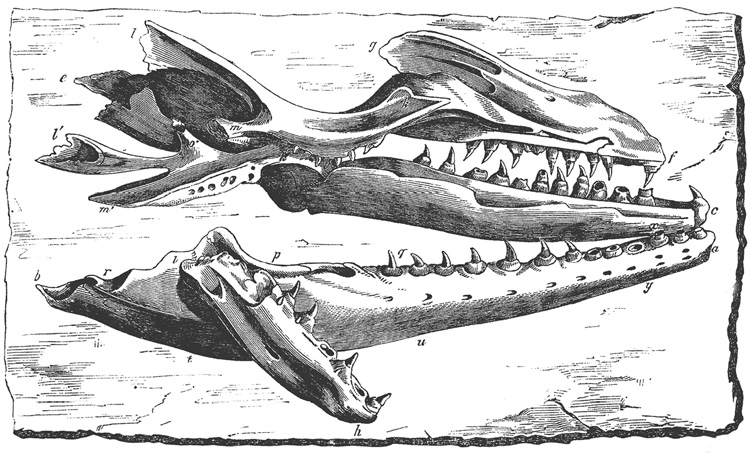
Pieter Harting published this engraving as the ‘Jaws of the Mosasaur’ in his book Album der Natuur in 1866. The original fossil was captured by the French in 1795 and taken to the Muséum National d’Histoire Naturelle in Paris, where it may still be found.
A second, similar, skull was excavated a few years later, on nearby land owned by Canon Theodorus Joannes Godding. He displayed it in his home as a curiosity until it was seen by a retired army doctor, Johann Leonard Hoffmann. Hoffmann was a keen fossil collector and decided this must be the skull of a crocodile. A friend of Hoffmann’s was the collector Drouin, and together they concurred that the remains were again those of a crocodile – or possibly a whale. French revolutionary forces under Napoleon occupied Maastricht in 1794, and this fossil was traded for 600 bottles of wine and taken as a trophy straight to Paris. Philosophers conventionally interpreted these petrified remains as coming from familiar creatures, and fossils were widely discussed by learned naturalists. Nobody imagined that fossils might be the remains of long-forgotten creatures, unknown to present-day scholarship, which had roamed the Earth in prehistoric times. It was assumed that the world then was much the same as the world of the past, though there was growing evidence that the Earth had changed over time. As long ago as 300 BC Aristotle’s young protégé Theophrastus had written a work entitled Peri Lithon (‘concerning stones’), which is the earliest work we know of that dealt with rocks. Theophrastus also noted that the draining of coastal swamps had rendered an entire area prone to freezing. He was also a pioneer of climate change, calculating that forest clearance resulted in warmer weather, because more heat could now reach the ground.32
The novel notion that the Earth could change over time was slowly emerging. A United Nations report quotes Vitruvius from around 50 BC, who recorded that many ancient settlements along the Anatolian peninsula in the Aegean Sea had been engulfed when changes in the landscape caused the sea to encroach. This is the first known record of major changes in the Earth’s surface. We now know that there are many ancient cities at the bottom of the sea – one in the Bay of Cambay, India, dates back 10,000 years, and there is another vast city on the bed of the Yucatán Channel near Cuba.33
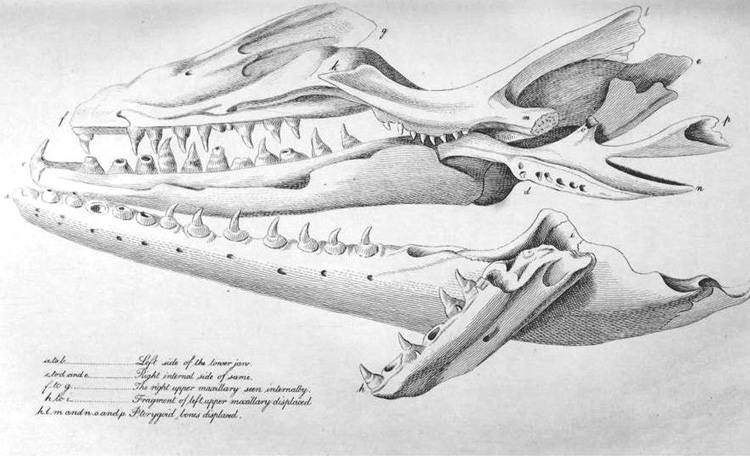
Georges Cuvier published this refined engraving as ‘The Mosasaurus of Maastricht, Huge skull found in a quarry at Fort St Peter near Maastricht, Netherlands, in 1780’ in his book The Animal Kingdom published in London by Whitaker & Co, 1830.
Another idea that was slowly emerging was that the prehistoric climate had also changed over time. The evidence first emerged from the remote villages of Switzerland, where the local people used to say that the gigantic boulders they found scattered along the valleys were signs that glaciers had once extended further down from the mountains. Pierre Martel, an engineer from Geneva, visited these villages in 1742 and later wrote about these stories. Perhaps the landscape and the climate had once been very different. At the time, this was an unpalatable prospect.34
At about the same time, a Swedish mining engineer, Daniel Tilas, was studying the erratic boulders in many of the Scandinavian countries and the nations bordering the Baltic Sea, and he similarly speculated that they were brought to their present positions by glaciers that had existed in the past.35
Matters were about to change with the revolutionary ideas of James Hutton, a Scottish farmer turned naturalist. Hutton had lectured on the structure of the Earth, and in 1785 he presented his findings in a lecture to the Royal Society of Edinburgh. He argued that many rocks were not original, primeval structures, but had been modified and subject to sedimentation and later to weathering. Hutton introduced a basic principle of modern geology, somewhat clumsily termed uniformitarianism, which states that the natural forces that we see operating on the landscape today are essentially the same as those operated in past æons. He concluded that the movement of rocks by prehistoric glaciers, like the progressive erosion of the coast, was the cause of the landscape around us. Geology was suddenly seen as relevant to the study of the present-day Earth.
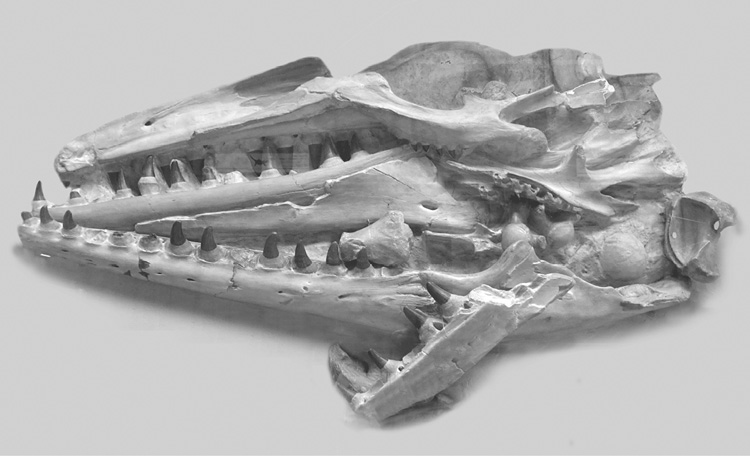
A replica of the original fossil from which the previous illustration was taken is on display in the Natural History Museum, London. The original specimen remains for the time being in the Muséum National d’Histoire Naturelle in Paris.
The term ‘geology’ had first been used by Ulisse Aldrovandi in his will of 1603, and came from the Greek γῆ (gē, earth) and λoγία (logia, study). Not until Hutton, however, was the subject given proper scrutiny and set on a firm scientific footing. Hutton used his principle of uniformitarianism to argue that many of the features of the present-day rocky landscape had begun at the bottom of the oceans, that many forms of rock had been produced by collections of ‘loose or incoherent materials’, and that these rocky layers were subject to rising, or falling, over the passage of immense periods of time. This was the first time anyone had put together the ideas fundamental to geology. In 1795, he finally published a book on his conclusions, and the new science of geology was firmly established.36
Several years after Hutton’s work, a Swiss hunter, Jean-Pierre Perraudin, decided to look further into the massive granite boulders that lay scattered around his home in the Alpine village of Lourtier. Perraudin was a professional hunter of chamois, the pretty mountain goats from which the finest leather is obtained. As he hiked across the mountains, he noticed two key facts: not only were there massive granite rocks scattered across the valley floor, but they were very different from the rocks nearby. They didn’t belong there. Secondly, he kept coming across deep longitudinal scratches and grooves carved into the valley sides. He sensibly concluded that this could mean only one thing – just as the villagers had always believed, glaciers had filled the valley in the past and had carried the boulders along, so it was these that had cut the deep grooves into the valley sides. Whenever an explanation for these curiosities had been sought in the past, philosophers said they were the evidence of the biblical flood, but Perraudin dismissed this as nonsense – he was certain that rising flood water could not move granite boulders. In 1815 he went to present his reasoned conclusions to Jean de Charpentier, born in Saxony and an enthusiast for geology, but Charpentier dismissed the idea as absurd. Undeterred, Perraudin raised the matter with a visiting engineer Ignaz Venetz, who lived in the nearby Rhône Valley, and the evidence he presented was so convincing that Venetz himself approached Charpentier and finally convinced him that the theory was right.37
Venetz worked further on the theory, and became convinced that – just as the hunter Perraudin had concluded – there had been eras in the past where glaciers had existed, and they had left indelible marks on the present-day landscape. He claimed that this proved that much of Europe had previously been covered with vast glaciers. At last it was becoming acceptable to say that the world’s climate truly had changed over time.38
Interest in this subject soon came to the attention of a physician and amateur geologist, Jean Louis Rodolphe Agassiz. He was born in 1807 in Môtier, in the French-speaking part of Switzerland, and qualified in Munich, Germany. He was soon to develop an interest in palæontology and he later studied in Paris under Georges Cuvier, who was greatly impressed by Agassiz’s growing knowledge of fossil fish. When Cuvier died, Agassiz saw himself as his natural successor, and later wrote an extensive work on fossil fish.39
As he developed his spare-time interests in natural history, Agassiz used to discuss his ideas with Karl Friedrich Schimper, a botanist turned poet and four years his senior. Schimper was a firm believer in the idea that prehistoric glaciation had created the landscape they saw around them, and he persuaded Agassiz that the views of Martel and, more recently, Perraudin, provided the evidence. Louis Agassiz devoted much of his free time to tracing changes in the Alps, monitoring snowfall and recording temperatures, and eventually he published an extensive monograph on glaciation. The title page of his book bears a vivid engraving of a glacier towering high above forest trees, and much of the contents comprises a comprehensive collection of detailed climatological tables.40



